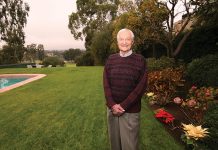March 10 marked the 96th Academy Awards. To celebrate, weâre looking back at a handful of metro Detroit and metro Detroiter appearances at . Not only do we boast incredibly cinematic architecture and landscapes, but we have tons of talented and creative neighbors. With state House and Senate legislation proposed last year that would bring back the film tax credit, weâre holding out for a local filmmaking renaissance that sweeps future ceremonies.
Telecast Moments and Nonmoments
Kim Hunter wins best supporting actress for her role as Stella Kowalski in (1952)
Kim Hunter was absent the night she bagged her first Oscar, for her unforgettable performance alongside a young Marlon Brando. Her friend Bette Davis did her best to approximate a Hunter speech: âShe would say: âHow wonderful, how grateful, and thank you very much.ââ
Hunter was born in Detroit and lived in Highland Park until her family moved to Miami Beach by the time she was 10. Around age 8, she auditioned for a show on WXYZ, which she recalled in a 1971 interview with the Detroit Free Press. At the time of the interview, she was in town for a stage production at the Fisher Theatre.
âComing back â my God, the names! The Penobscot Building! Hudsonâs! Thatâs all a large part of my memories,â she said.
Ellen Burstyn wins best actress for her role as Alice Hyatt in Alice Doesnât Live Here AnymoreÌý(1975)

Ellen Burstyn was also absent the night she won her first Oscar. She was in New York, acting in the Broadway play Same Time, Next Year, and director Martin Scorsese accepted the award on her behalf. Kind of a shame, considering sheâd been practicing her Oscar speech since she was 7 years old and living in Detroit.
She and her older brother, Jack, attended St. Maryâs Academy in Windsor, Ontario, a Catholic boarding school demolished in 1977. At 13, she began modeling for Crowleyâs department store in downtown Detroit, and she later modeled for its competitor Hudsonâs in her late teens. She went to Cass Technical High School, where she was a cheer captain, but dropped out her senior year and eventually moved to New York.
Burstyn was nominated for two previous roles and would be nominated three more times. At the 1977 ceremony, she introduced then-breakout star Sylvester Stallone. That night, Rocky won three awards, including best picture.
Robin Williams wins best supporting actor for (1998)

Following three empty-handed Oscars departures since 1987, Robin Williamsâs role as lovable therapist Sean Maguire finally earned him his first (and only) Academy Award.
The late actor delivered a very on-brand speech â kind, humorous, and self-deprecating. His final thanks went to his deceased father, Robert Fitzgerald Williams,âthe man who when I said I wanted to be an actor, he said, âWonderful, just have a backup profession like welding.ââ
Robert worked in Ford Motor Co.âs Lincoln-Mercury Division and moved the Williams family to metro Detroit in the late â50s, where Robin spent much of his childhood. The family lived in a Bloomfield Hills home on Woodward and Long Lake. He attended Detroit Country Day School, where he was on the soccer and wrestling teams.
wins best feature documentary (2003)

OK, not technically metro Detroit, but we couldnât resist. At the 75th ceremony, Flint native and director Michael Moore won his first and only Oscar.
Capitalizing on the moment, Moore rounded up the other nominees and took to the stage to deliver what was â at the time â a relatively controversial speech criticizing the U.S. invasion of Iraq that had commenced just days earlier, calling out President George W. Bush by name.
âWe live in a time where we have a man sending us to war for fictitious reasons,â Moore belted, as a mix of boos and cheers began to erupt from the audience. âWe are against this war, Mr. Bush! Shame on you, Mr. Bush!â
âLose Yourself â wins best original song (2003)

Eminem made history in 2003 when his âLose Yourselfâ became the first Oscar-winning rap song. But much like the odds were stacked against 8 Mileâs main character, Jimmy âB-Rabbitâ Smith, in his quest for rap stardom, it seemed unlikely that the filmâs theme could snag the award.
One of the biggest doubters was Em himself, who skipped the ceremony altogether, admitting in a 2007 Shade 45 interview he thought the song had âa snowballâs chance in hellâ of winning at the time. He had already drifted to sleep at home when his co-writer Detroit musician Luis Resto took to the stage to accept the award (Jeff Bass, the third co-writer and a fellow Detroiter, who created the songâs driving guitar riff, was also absent â his wife had just given birth).
Restoâs unbuttoned sports jacket parted to reveal a red Pistons jersey with the number 33, worn by the teamâs fo mer forward Grant Hill. Seventeen years later, the rapper showed up to deliver a surprise performance of âLose Yourselfâ at the 92nd Academy Awards in 2020.
wins best feature documentary (2013)

In 2012, countless U.S. moviegoers were introduced to musician Sixto Rodriguez via Searching for Sugar Man. The documentary revealed that the obscure, soft-spoken Cass Corridor folk singer had risen to Bob Dylan-level superstardom in South Africa in the 1970s (and in Australia, though this fact didnât make the cut), unbeknownst even to him for some time.
Director Malik Bendjelloul and producer Simon Chinn accepted the award; Rodriguez was absent. âRodriguez isnât here tonight, because he didnât want to take any of the credit himself,â Chinn said in his acceptance speech. âAnd that just about says everything about that man and his story that you want to know.â
Bendjelloul would die tragically by suicide about a year later at the age of 36. Rodriguez passed away in 2023 at 81, old enough to see his songs finally receive their due domestically.
Oscar Locations
(1998)

The crime thriller/rom-dramedy is set partially in Detroit, where much of the principal photography took place. Scenes include a boxing match filmed in Detroitâs Fillmore theater (then the State Theatre) and a steamy dinner scene with characters Jack (George Clooney) and Karen (Jennifer Lopez) in the Renaissance Centerâs rooftop restaurant. It received editing and writing nominations in 1998.
(2002)

Set and largely shot in Detroit, the film features iconic locations like Detroitâs New Center Stamping plant, The Shelter under St. Andrewâs Hall (where Eminem used to compete in real-life rap battles), the Michigan Building (where a parking lot rap battle takes place), and the giant cow head on Mack Avenue in Detroit (which B-Rabbit and his crew bombard with a paintball gun). When B-Rabbit goes to hip-hop station WJLB in hopes of furthering his career (only to discover his girlfriend stepping out on him), he enters the lobby of the Penobscot Building â the real-life lobby for WJLBâs studios before it relocated to Farmington Hills.
(2007)

Detroitâs iconic Michigan Central Station plays the role of the Beaux-Arts building in Michael Bayâs debut franchise title. Bay would return to Detroit to shoot several of the sequels, including fellow Oscar nominee Transformers: Dark of the Moon (2011), in which many iconic landmarks can be glimpsed, including the Fisher Building lobby, Michigan Central (again), and Meadow Brook Hall in Rochester. Since 2007, the Transformers films have received three nominations for sound mixing, two for visual effects, and one for sound editing.
(2011)

The political thriller starring George Clooney, Ryan Gosling, and the late Philip Seymour Hoffman took full advantage of Michiganâs then generous tax credits â with key scenes shot at Detroitâs Cliff Bellâs and Firebird Tavern, The Dearborn Inn, Nickâs Country Oven in Clawson, and Christ Church Cranbrook in Bloomfield Hills. The film was nominated for best adapted screenplay in 2011.
This story is from the March 2024 issue of Â鶹·¬ºÅ Detroit magazine. Read more in our digital edition.
|
| Ìý |
|








